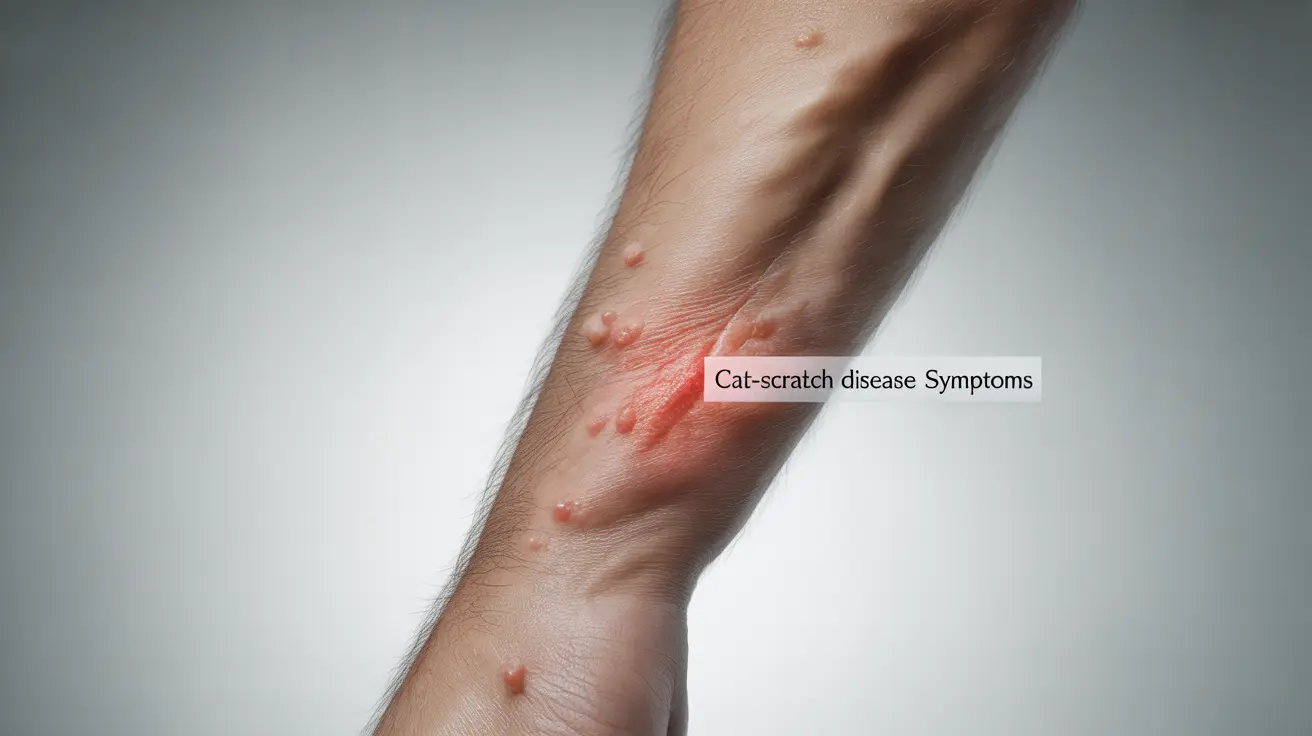Cat-scratch disease (CSD) is a bacterial infection that typically occurs after being scratched or bitten by a cat carrying Bartonella henselae bacteria. While usually mild and self-limiting, understanding its symptoms and proper management is crucial for anyone who interacts with cats regularly.
This comprehensive guide will explore the key symptoms, timeline, treatment options, and prevention strategies for cat-scratch disease, helping you make informed decisions about your health and pet interactions.
Initial Signs and Symptoms of Cat-Scratch Disease
The progression of cat-scratch disease typically follows a predictable pattern, with symptoms appearing in stages:
Primary Symptoms
The first signs usually develop 3-14 days after the initial scratch or bite:
- Small bumps or blisters at the injury site
- Mild redness and swelling around the wound
- A small, firm, raised area that may be warm to touch
- Possible mild fever
Secondary Symptoms
Within 1-2 weeks after the initial symptoms, additional signs may develop:
- Swollen and tender lymph nodes, usually near the site of the scratch
- Fatigue and general malaise
- Low-grade fever (under 102°F/39°C)
- Headache
- Decreased appetite
Duration and Recovery Timeline
Cat-scratch disease typically follows a predictable course of recovery:
- The initial site reaction usually heals within 2-3 weeks
- Lymph node swelling may persist for 2-4 months
- Most cases resolve completely without treatment within 4-6 months
Treatment Options and Management
Medical Intervention
While many cases resolve on their own, certain situations may require medical treatment:
- Severe or persistent symptoms
- Compromised immune system
- Involvement of sensitive areas like the eyes or joints
- Development of complications
Home Care Measures
Several self-care strategies can help manage symptoms:
- Warm compresses for swollen lymph nodes
- Over-the-counter pain relievers
- Adequate rest and hydration
- Keeping the scratch or bite area clean
Prevention Strategies
Preventing cat-scratch disease involves several key practices:
- Wash hands thoroughly after handling cats
- Clean cat scratches or bites immediately with soap and water
- Avoid rough play that might lead to scratches
- Keep cats' nails trimmed
- Maintain regular flea control for your cats
Risk Factors and Special Considerations
Certain groups should take extra precautions:
- Children under 12 years old
- People with weakened immune systems
- Healthcare workers
- Veterinary professionals
- Those with multiple cats
Frequently Asked Questions
What are the most common symptoms of cat-scratch disease, and how soon do they appear after exposure?
The first symptoms typically appear 3-14 days after exposure, beginning with a small bump or blister at the scratch site. This is followed by swollen lymph nodes, mild fever, and fatigue within 1-2 weeks of the initial symptoms.
How long does it take for cat-scratch disease symptoms to go away, and when should I see a doctor?
Most symptoms resolve within 2-4 months. Seek medical attention if you experience severe pain, high fever, spreading redness, or if symptoms persist beyond 4 months.
Is treatment with antibiotics necessary for cat-scratch disease, or does it usually get better on its own?
Most cases resolve without antibiotics. However, treatment may be prescribed for severe cases, immunocompromised patients, or when complications develop.
What steps can I take at home to relieve pain and discomfort from cat-scratch disease?
Apply warm compresses to swollen areas, take over-the-counter pain relievers, rest adequately, and keep the affected area clean. Stay hydrated and monitor your symptoms.
How can I prevent cat-scratch disease, and are certain people or cats more likely to spread the infection?
Prevent infection by washing hands after cat contact, cleaning wounds promptly, and avoiding rough play. Young cats and kittens are more likely to carry the bacteria. People with weakened immune systems face higher risk and should take extra precautions.




